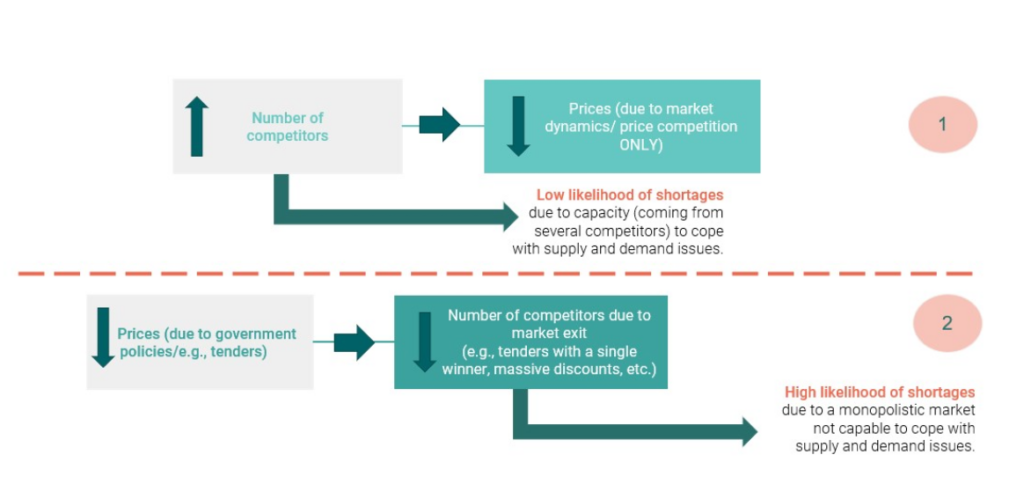Drug shortages are an industry-wide problem. Numerous factors may be considered as contributing to drug shortages across the globe. In this report, we discuss the global issue of drug shortages, summarise the main reasons for shortages as presented in the literature and our quantitative analysis. Finally, we provide recommendations for policy makers.
Key takeaways
- Drug shortages occur globally, across a range of therapeutic areas, but appear to be mostly centered around the generic and biosimilar markets.
- The causes of drug shortages are interlinked, multifactorial, with the root cause often difficult to establish.
- The issue of low prices in the generic and biosimilar markets appears to be a key driver of drug shortages, often underlying the causes of drug shortages.
- Drug shortages can have a large economic and health impact on patients.
- The duration of shortages has either increased or remained the same.
- Price erosion does not appear to be driven by competition between manufacturers, since the markets are highly concentrated, but instead from other dynamics that are captured in the literature (e.g., tenders). (Figure 1)
- All the identified factors in the literature and in our framework are related to price erosion either directly or indirectly and therefore price erosion is likely to be one of the most significant drivers of shortages.
- Most shortages affect off-patent drugs with low prices. This means that unattractive markets are leading to oligopolies, increasing the shortage risk significantly as there are no alternatives and no bandwidth for the other manufacturers to pick up all the volumes.
Figure 1: Graphical illustration of the relationship between price, competition, and shortages.

Drug shortages are becoming more commonplace
Whilst drug shortages are not new, there has recently been an increase in frequency and scale, as well as receiving greater media and political attention. Shortages cause significant patient, economic and health system impacts, with governments around the world currently grappling with how to solve the issue.
Drug shortages can be complex and have multiple contributing factors, meaning that the root cause can be difficult to establish. Our latest research sheds light on this difficult topic and found that the key drivers of shortages can be categorised into three causes.
- Demand-side increases for a drug,
- Supply-side production issues,
- Misalignment of government policies, manufacturer strategy, and financial incentives.
Demand-side issues usually occur when there is a rapid rise in the need for a drug, and production cannot keep pace. This was seen in late 2022 when there was a rise in respiratory infections leading to a shortage of Amoxicillin ( Eversana, 2022).
Supply-side issues involve any manufacturing problems, unavailability of resources, or logistical issues that may lead to a shortage. An example of this is in the USA, where several cancer medicines have been in shortage for several years due to manufacturing and supply chain issues (Elzawawy and Kerr, 2013; Elzawawy, 2015).
The misalignment of policies and financial incentives can often underlie many different drug shortages.
We examined the reasons driving drug shortages
By examining drug shortage databases from the USA, Canada, and the European Union we found that the incidence of shortages has increased, particularly since the COVID-19 pandemic. Demand increases for drugs as well as the discontinuation of drugs are key reasons for shortages globally.
Whilst shortages occur across different therapeutic areas and drug presentations, they occur mostly in off-patent medicines such as generic and biosimilar drugs like Table 1 shows.
This was particularly prevalent in the USA and Canada where over 95% of shortages were seen in off-patent medicines. Similarly, the companies experiencing the most shortages are generic and biosimilar manufacturers.
The concentration of shortage incidents in the off-patent market may be due to these being commercially unattractive markets with low-profit margins and significant price erosion which results in markets with few producers. This means there is limited bandwidth in the market and less resilience when there is a demand increase or a supply issue, therefore a higher likelihood of a shortage occurring.
This price erosion is unlikely to be driven by competition between manufacturers, as the markets are concentrated, but instead from other dynamics such as tenders. As a result of price erosion, the pharmaceutical market’s sustainability and competitiveness are under threat ( Francois et al., 2023).
Furthermore, drug shortages can have a significant economic and health impact on patients. On the patient side, this could be due to side effects from a substitute drug or prescribing errors. The economic consequences could include higher out-of-pocket payments for patients as well as more resources being diverted to controlling shortages rather than other healthcare resource utilisation.
Recommendations
Governments around the world have been working to alleviate drug shortages, with several policy initiatives seeking to address the main causes. However, the effectiveness of these policies has yet to be demonstrated.
The European Commission has proposed methods to cope with shortages that, while aiming to address numerous causes of shortages, are problematic in terms of feasibility and how they will be interpreted by governments (e.g., the Voluntary Solidarity Mechanism). Other prospective policies (for example, on partnerships and supply chain diversification) may be more effective if they incorporate other factors, such as price levels and incentives, in their design.
Before applying any of these policies, the relationship between shortage drivers (e.g., price erosion) and actual shortages should be quantified. In order to do so, we recommend that stakeholders and policy makers apply the drug shortages framework described in our report. In particular, this framework consists of five correlated factors (i.e., i) price change of the originator, ii) price change of other products with the same molecule, iii) market concentration, iv) demand and competition, and v) patent expiration), which can be used to determine shortages’ factors and value ranges to document or even forecast a shortage. Overall, this framework will help them to determine the relationships between shortages and their drivers, and hence design relevant and feasible policies.
Further key points
- Since the COVID-19 pandemic, where drug shortages have become more of a critical issue, governments globally have been making efforts to address them, with several policy proposals attempting to address the underlying causes. (The success of these policies has not been established yet).
- Most shortages affect off-patent drugs with low prices. This means that unattractive markets are leading to oligopolies, increasing the shortage risk significantly as there are no alternatives and no bandwidth for the other manufacturers to pick up all the volumes.
- Increased medicine demand, particularly in recent years, as well as the disruption or discontinuation of product manufacturer, are identified as major causes of drug shortages.
- Pediatric, Gastroenterology, Anesthesia, Nervous system, Cardiovascular and Anti-infectives are the main therapeutic classes experiencing shortages, although there are many shortages across different therapeutic areas.
- Infusion and Injectables followed by Tablets and Capsules are the most common drug presentations to experience drug shortages.
References
- Elzawawy, A., 2015. The Shortage of Essential Cancer Drugs and Generics in the United States of America. Global Brain Storming Directions for the World. International Journal of Cancer and Clinical Research, [online] 2(2). 10.23937/2378-3419/2/2/1016.
- Elzawawy, A.M. and Kerr, D.J., 2013. Variation in the availability of cancer drug generics in the United States of America. Annals of Oncology, 24, pp.v17–v22. 10.1093/annonc/mdt324.
- Eversana, 2022. English Pharmacies Making a Loss When Dispensing Strep A Antibiotics, Amid Surge in Infections. Navlin Daily. Available at: https://www.navlindaily.com/article/15115/english-pharmacies-making-a-loss-when-dispensing-strep-a-antibiotics-amid-surge-in-infections [Accessed 7 Jun. 2023].
- Francois, C., Gawlik, G., Mestre-Ferrandiz, J., Pana, A., Perelman, J., Yfantopoulos, J. and Simoens, S., 2023. New pricing models for generic medicines to ensure long-term sustainable competition in Europe. Frontiers in Pharmacology, [online] 14. Available at: https://www.frontiersin.org/articles/10.3389/fphar.2023.1200641 [Accessed 13 Oct. 2023].
This consulting report, ’The Dynamics of Drug Shortages’, was commissioned and funded by Organon Pharma (UK) Limited.




